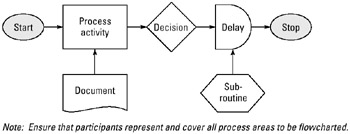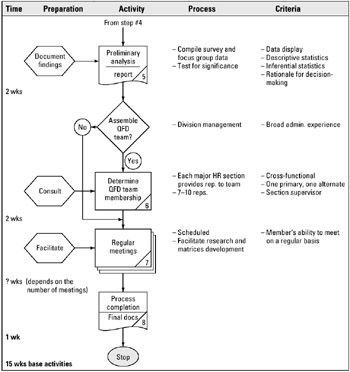Tool 149: Process Flowchart
| AKA | Process Flow Analysis |
| Classification | Analyzing/ITrending (AT) |
Tool description
A process flowchart illustrates the major activities, sequence, and flow connections of a work process or project. The flowchart helps a team gain a common understanding of the overall process and its interrelationships. The flowchart can be used to identify problem areas, document a process, or serve as a planning tool for process improvement.
Typical application
-
To illustrate the flow or process steps in manufacturing a product, providing a service, or managing a project.
-
To provide a common understanding of a complex process.
-
To recommend an improved process to the process owner.
Problem-solving phase
| → | Select and define problem or opportunity |
| → | Identify and analyze causes or potential change |
| → | Develop and plan possible solutions or change |
| Implement and evaluate solution or change | |
| Measure and report solution or change results | |
| Recognize and reward team efforts |
Typically used by
| Research/statistics | |
| Creativity/innovation | |
| 2 | Engineering |
| 5 | Project management |
| 3 | Manufacturing |
| Marketing/sales | |
| Administration/documentation | |
| 4 | Servicing/support |
| Customer/quality metrics | |
| 1 | Change management |
before
-
Information Needs Analysis
-
Systems Analysis Diagram
-
Variance Analysis
-
Problem Analysis
-
Pareto Chart
after
-
Process Mapping
-
Problem Specification
-
Opportunity Analysis
-
Work Flow Analysis (WFA)
-
Action Plan
Notes and key points
-
Legend for process flow chart symbols:

Step-by-step procedure
-
STEP 1 As a first step, the team facilitator assembles a team whose participants thoroughly understand all aspects of the process. See Example Reengineering Human Resources.
-
STEP 2 The overall scope of the process flowchart is determined. A starting and stopping point is identified.
-
STEP 3 Next, participants identify all major process steps and the sequence of completion. Reviews, delays, documents, reports, and other important activities are recorded on another flipchart.
-
STEP 4 The facilitator uses a whiteboard to start drawing the process flowchart. The participants assist the facilitator in drawing and connecting all process steps in the correct sequence.
-
STEP 5 Depending on the level of detail agreed upon, additional information can be noted along with the process steps, as shown in the example.
-
STEP 6 Finally, the process flowchart is verified for accuracy and dated.
Example of tool application

Reengineering Human Resources

EAN: 2147483647
Pages: 326